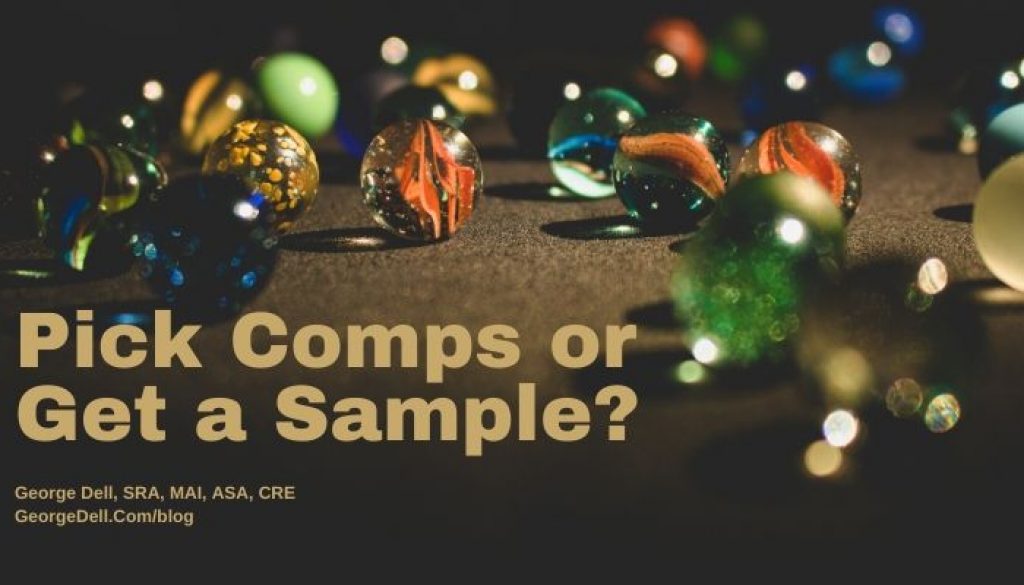Take a sample or pick comps: different or the same?
Most of us grew up first learning descriptive statistics: mean, median, standard deviation and such. Later, we learned that it was usually impossible or too expensive to get all the data, so we got a sample which seemed to be like the whole ‘population’ we wanted to represent. It was intuitive and made sense!
We are shown a large bucket filled with green and brown marbles. Next, we grab a handful of them to estimate the proportion of green marbles.
Then they tell us that grabbing a sample might be biased. How could this be? We grabbed a handful from the top of the bucket, and counted 9 brown, and only 3 green. This is too easy! The bucket is 75% brown marbles . . .
Then the teacher said wait! What if. “What if I had first grabbed bunches of green marbles, then threw the handfuls brown marbles on top.” (And even shook the bucket a bit.) Do you still think the bucket is three-quarters brown? Easy answer. Of course not. I’m pretty smart. It is more green now.
How much more green? Well, it depends on how many were in each handful when the teacher started!
This is a short way to understand why sampling is not easy. In my graduate classes in statistics and econometrics, at least three were devoted mostly to samples. And sampling.
It turns out there are many forms of sampling. Each take judgment by a human. For valuation, there are three main ways to look at our data selection.
Judgment sampling. One method is discussed in The Appraisal of Real Estate 14th edition (TARE). It starts with “Appraisers rarely have access to all available information … The data used by appraisers is seldom a random sample.” Then it says: “More often, appraisers deal with judgment samples … on the basis of personal judgment…thought to be a representative group.”
Statistical sampling. Most people think that statistical sampling is random sampling – because that’s what was taught. And that’s what made things like estimating brown and green marbles “quantifiable.” You could then figure out how sure you could be that the brown/green proportion or count is close to the actual amount, if you could just count the whole bucket!
The whole bucket. If we just had a way to count the whole bucket it would be so much better. But that is tedious by hand. Only if!
Today we have technology. Science. A machine that can tell colors. And it can count, instantly. (Kinda like the dollar bill counters at the bank!) Wonderful – we will never need bank tellers ever again! Ever!
What has really happened is that the bank tellers are more accurate, faster, and do other things.
This is where appraisers must go: more accurate, faster, and provide other things.
This is data science. It’s using technology to become more accurate, faster, and provide additional valuation services. This is the future. It will benefit clients, lenders, GSEs, regulators, investors, and agencies, who are charged with fairness, such as tax assessors and the courts.

June 3, 2020 @ 12:40 pm
300 sf +/- (for large houses, more gla +/-) ; 10 yrs from year built +/- (up to 20); use mls tool to include area to be searched; search 365 days back; more for ADDITIONAL support; search parameter the site size within the range for the neighborhood or area (urban, suburban, rural residential etc) If there are insufficient comps resulting, then there are insufficient comps. THEN GO SHOOT THEM ALL, if its same tour of subject inspection. I typically shoot 15-20 including pendings and actives. U cant just “pick” comps before you inspect. SO ok its a sample, of everthing withing RANGE of comparability; then they can be analyzed and reduced to the sacred 1st 3, with more for support. The GSE’s and others have told us the limits of what they will accept; those can serve as rough parameters for the major attributes. Dont put this under a microscope to solve a macro problem. Oh, and the above “parameters” are not cast in stone, but u got the gla, the age, site size and ESP “LOCATION”(X3) ie market area parametered (bracketed like artillary), there’s ur comp pool. SELECTING 3 (OR MORE) COMPS BEFORE U GO IS BOGUS, SKIPPY PRACTICE.
June 4, 2020 @ 9:00 pm
Neil.
You are on the right track! Thanks for commenting . . .